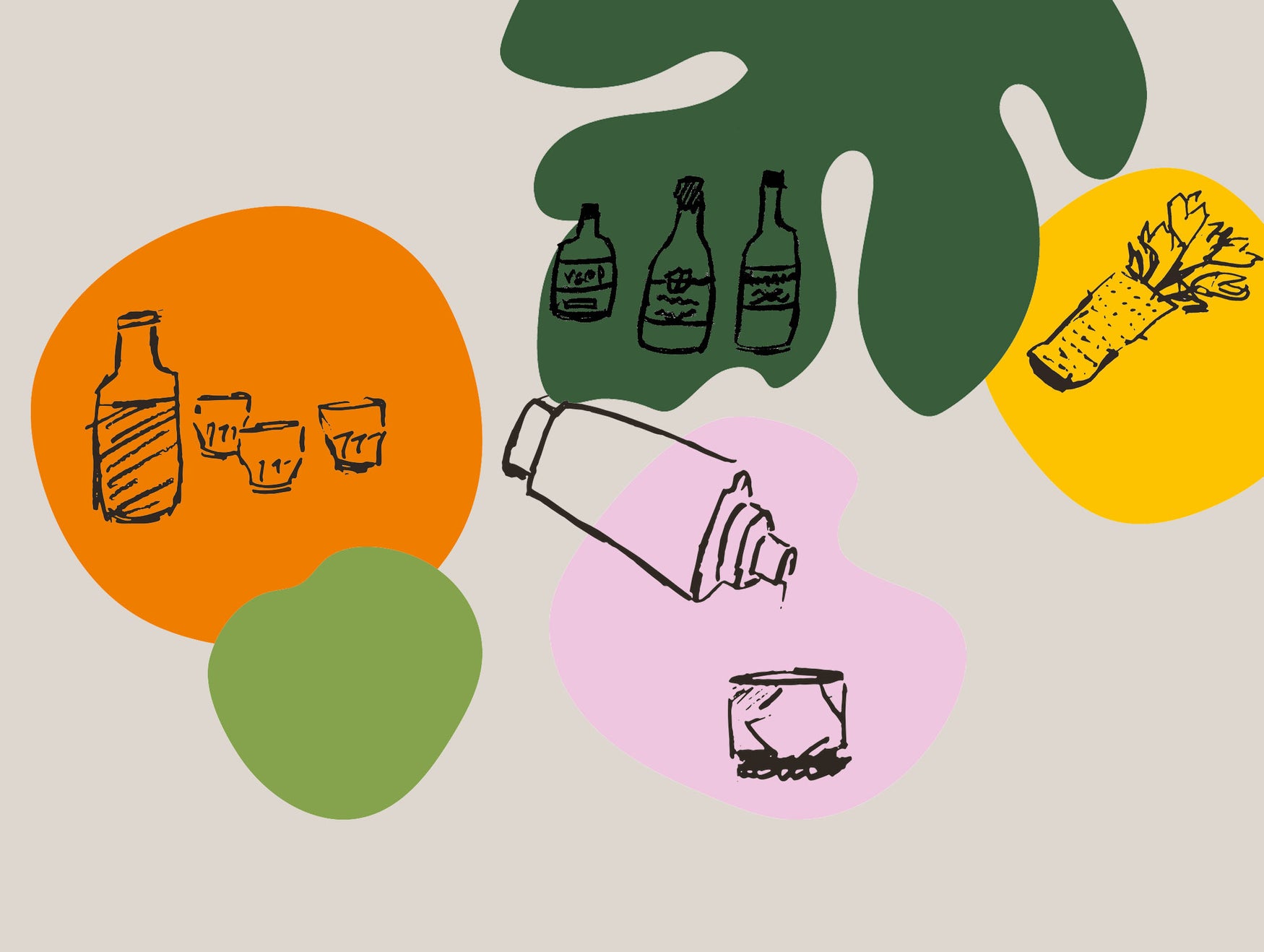We're exploring twelve seasonally-inspired cocktail recipes this year alongside our candle subscription with writer, historian, and cocktail creative Al Culliton.
Table of Contents
Basic Tools
Glassware
A Note on Amaro
Al's Toddy Method
A Note on Liquers
What are Gentian liqueurs?
What's a Cobbler?
What's a Shrub?
Past Drinks Recipes
As the months proceed, we'll share here a growing number of tips and introductions to the basics of cocktail making — from tools and glassware to notes on less common ingredients.
BASIC TOOLS
To most easily create Al's drink recipes, you'll need some basic cocktail-making tools. Al recommends cocktailkingdom.com and viski.com for bar essentials. Less than $80 should get you everything you need. Failing that, you will be able to make do with standard kitchen tools in the worst case (see our suggestions in parentheses).
- Cocktail shaker (alt. a masor jar with lid will do)
- Mixing glass (alt. a large ice tea glass will do, preferably with a wide base)
- Strainer (alt. a kitchen sieve, preferably small, will do)
- Fine strainer (alt. as above, worst case grab a sieve). The fine strainer is used less, but when it is, it's important to achieving the desired texture (as in drinks with egg white, etc.).
- Bar spoon (alt. a chopstick can work, but get yourself a bar spoon!)
- Jiggers or measuring cups and spoons. Many jiggers have a 1 oz. and 2 oz. side; the smaller side will typically have ¾ and ½ oz. lines on the inside. For smaller measurements, you can use measuring spoons.*
- Muddler
- Microplane (alt. any grater can work, but microplanes rock)
- Standard kitchen tools for making orgeat, syrups, etc. (e.g. whisks, pans)
*For those using kitchen cups/spoons, here's a quick conversion chart:
2 oz. = ¼ cup
1 oz. = ⅛ cup
½ oz. = 1 tablespoon
¼ oz. = 1½ teaspoons
Anything smaller is done in teaspoons or fractions thereof.
Scant and heaping measurements
Scant means you’re just underpouring on the measurement. Heaping means you’re going slightly over. You’ll see this with smaller measurements like teaspoons or ¼ ounce measures.
 Barware set by Viski.
Barware set by Viski. GLASSWARE
A great cocktail is finished with a great glass. Again, cocktailkingdom.com and viski.com are great for cocktail glassware, or Al highly encourages looking for vintage glassware in local thrift stores.
- Double rocks glass: Your reusable Keap tumbler is basically a double rocks glass!
- Stemmed cocktail glass: Coupes, Nick & Nora glasses, or similar (4-6 oz.)
- A tall glass: Highball or collins glass (about 12 oz.)
- Mugs or teacups for hot drinks (8-12 oz., depending on recipe)

"Glassware I couldn't live without" and their typical volumes. Illustration by Al Culliton
A NOTE ON AMARO
Amaro is one of the best ways of traveling overseas from the comfort of our own home or, maybe, your favorite bar. It’s one of my absolute favorite things to serve after a meal and it’s the toughest thing for me to keep in stock at my house because I love drinking it so much. Our cocktails are designed using Braulio Amaro, a beautiful digestivo from the alps that features notes of conifer, white flowers, and gentian root. But there are plenty of amari that would work in our cocktails, and they can take you all over Italy via your tastebuds. Averna will take you to Sicily, Meletti to the Adriatic coast, and Ramazzotti will bring you to the piazzas of Milan. Our cocktails are also great with: Sfumato Rabarbaro, Zucca, Cynar, or Varnelli’s Amaro Sibilla.

AL'S TODDY METHOD
The goal with toddies, and all hot drinks, is to ensure that all of the elements (including the mug) are as hot as possible when building the drink. Here’s how we like to do it:
- Boil water.
- Fill the mug you’re going to make your toddy in with boiling water and set aside.
- If you’re using tea, cider, or similar, prepare those separately. For tea, brew a teabag or loose tea in a teapot or separate mug. I use 4-6 oz. water depending on the recipe. If using a mug, make sure you cover it with a saucer to trap the heat. Set your tea timer; I favor 5-6 minutes so the flavor can stand up to the other flavors in the drink. For something like cider, you’ll want to heat it on the stove in a small saucepan.
- To heat the spirituous elements, pour a few ounces of hot water into a large rocks glass or similar. Combine your spirit, liqueur, and/or fortified wine in a conductive vessel, like a metal cup or a small cocktail shaker tin. Carefully place the tin into the rocks glass of hot water. Stir the mixture to circulate heat.
- When your tea timer is up, remove the tea bag or strain out loose leaf tea and stir whatever sweetener you’re using into the hot tea.
- Toss out the warming water from your tea cup/mug.
- Pour in the heated spirits, then the sweetened tea.
- If using a small measure of citrus juice, add it now.
- Garnish with fresh spices, citrus, or what have you.

A note on liqueurs
Liqueurs are a misunderstood category, as there are a lot of subpar products on the market that consist mostly of sugar, neutral grain spirit, and flavoring agents. But a well-made liqueur is a thing of beauty and can be used to great effect in cocktails. It is for this reason that liqueurs have such a long history in punches and cocktails. A high-quality 750mL bottle of liqueur should cost between $25-45. These products are typically used in small amounts and will keep for a long time, so think of it as an investment! For example, crème de cacao is a chocolate liqueur that’s on the sweet side and typically hovers around 25% ABV. Al's recommended brands for crème de cacao are:
- Tempus Fugit (Al's favorite)
- Giffard
- Marie Brizard
- Destillare Intense Chocolate liqueur (this one is a little higher ABV and lower in sugar, so you may want to adjust your recipe to taste; that said, it’s great and made with a high-quality American brandy base)

What are Gentian liqueurs?
Gentian root is a common bittering agent in aromatized wines and bitter liqueurs, but gentian liqueurs, called gentianes in France, refer to a specific genre of French liqueurs. This subcategory of liqueurs originated in the Alps, where gentian is plentiful and inhabitants sought to capture the healthful properties of the distinctive roots, herbs, and flowers that grow there. Suze and Salers are perhaps the most recognizable brands, but Avèze and the gentian-infused aromatized wine Bonal can also be used to great effect in cocktails.

What's a Cobbler?
Cobblers are a genre of drinks that originated in the early nineteenth century. They typically use fortified wine (sherry chief among them) as their base, but spirits can also act as a Cobbler base. The wine is shaken with citrus and sugar, strained over crushed ice, and often features an over-the-top garnish of mint, fruits, and citrus wheels. The Cobbler was one of the first cocktails to demand ice as part of its preparation and helped popularize the use of the straw. The cobbler shaker — which features a main chamber, a top with an integrated strainer, and a cap to seal it — is still in use today.
What’s a Lewis bag?
A Lewis bag is a heavy canvas bag designed to help you crush ice neatly. When used in conjunction with a wooden mallet, the Lewis bag contains the ice as you crush it. Crushed ice is often used interchangeably with pebble ice, which requires a special machine to make, and is usually found in specialty cocktail bars, not on your average home bar. The dynamic duo of Lewis bag and mallet is great for the home bartender who loves pre-Civil War Cobblers, Fixes, and Juleps, or those who love to make tropical drinks at home.

What's a Shrub?
A note on shrubs: Shrubs were a very common method for preserving summer fruits, much like making a jam or jelly. Through the use of both sugar and vinegar, the bounty of summer is captured in a bottle. During the eighteenth and early nineteenth centuries, recipes for all kinds of shrubs popped up in many recipe books. At the time, water wasn’t very safe to drink, and adding vinegar and sugar both preserved the fruit and made the water in the shrub potable. You can have fun pairing different vinegars with whatever fruit you’re using. Personally, I like red wine vinegar for red fruits; white wine vinegar for peaches, apricots, and nectarines; and apple cider vinegar for blueberries!

Recipe Links
2022 Drinks Recipes
January — Janus
February — Ignis
March — Terra
April — Flora
May — Apium
June — Junius



















